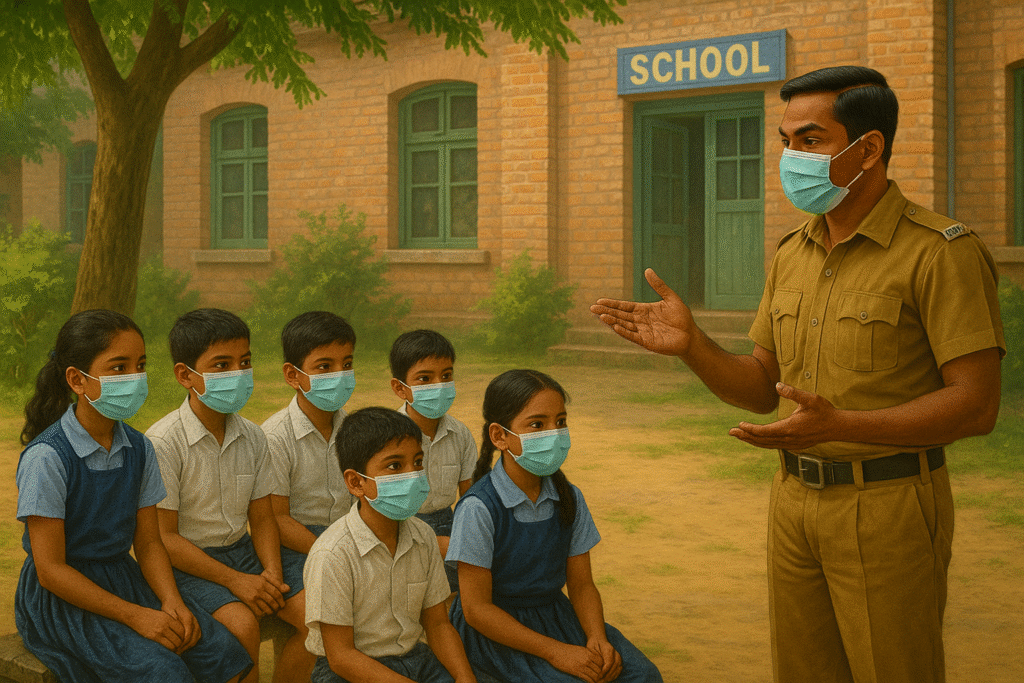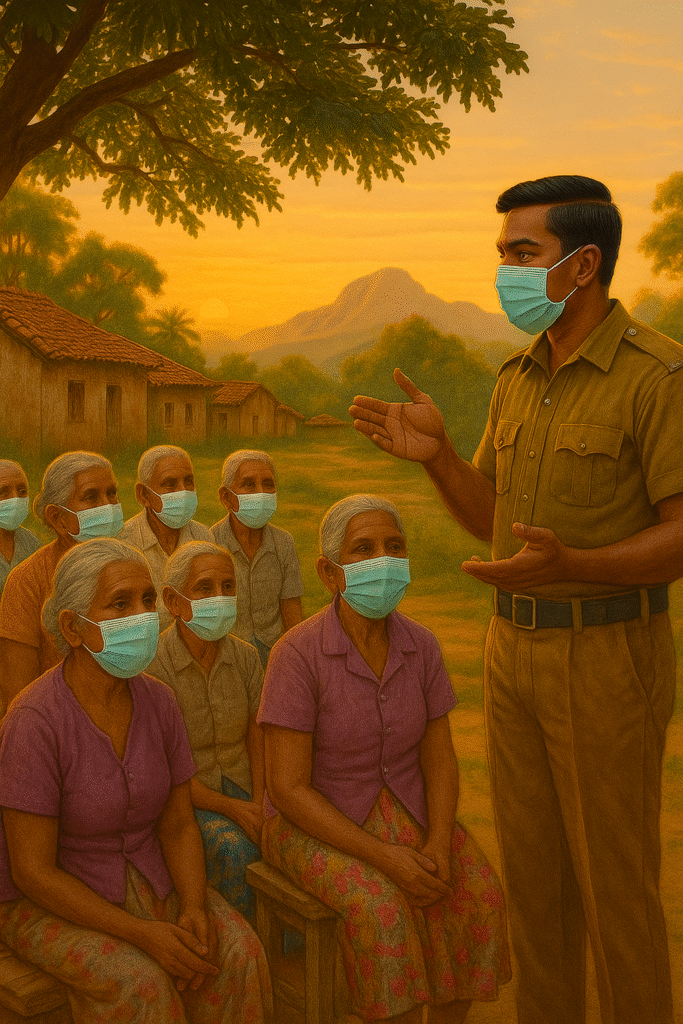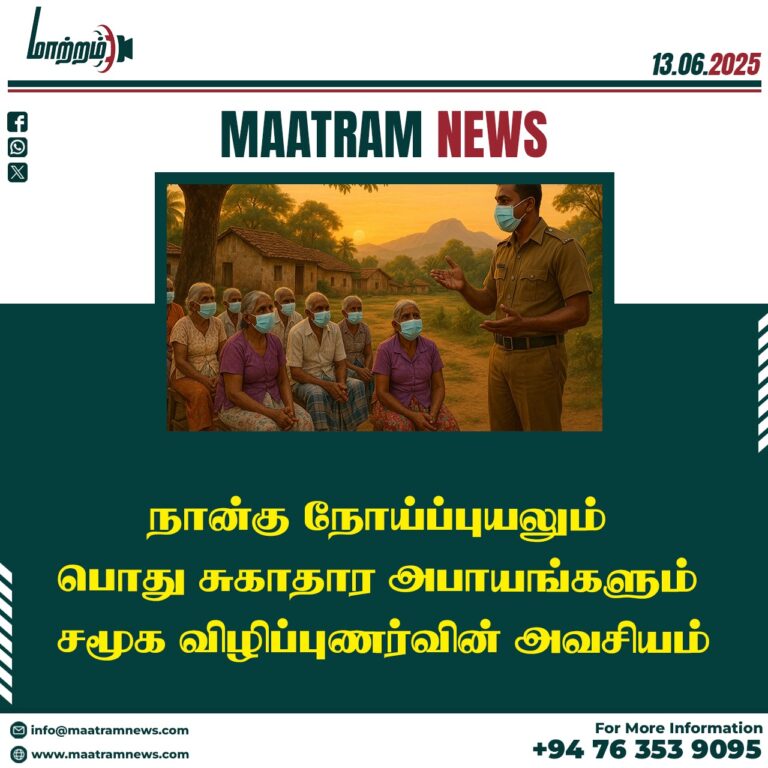இலங்கையின் பொது உடல்நலத் துறை இந்த கணத்தில் பன்முக அழுத்தங்களுக்கு உட்பட்டுள்ளது. பருவகால இன்ஃபுளுவென்சா/காய்ச்சல், டெங்கு, சிக்குன்குன்யா ஆகிய மூன்று நோய்களின் பரவல் வேகமாக அதிகரித்து வருகையில், அண்டை நாடான இந்தியாவில் புதிய கோவிட்-19 துணைவகை (JN.1 மற்றும் அதன் வழித்தோன்றல்கள்) நோய்த்தொற்றுகள் அதிகரிப்பதால், நான்காவது அபாயமான கோவிட் மறுசீரமைப்பு குறித்த அச்சங்களும் வலுப்பெற்றுள்ளன. இந்த ஒருங்கிணைந்த சவால், நோய்த்தடுப்பு மற்றும் கட்டுப்பாட்டு நடவடிக்கைகளின் அவசியத்தை முன்னிலைப்படுத்துகிறது, ஆனால் முக்கியமாக, தனிப்பொறுப்பு, சமூக விழிப்புணர்வு மற்றும் துல்லியமான தகவல் முகாமைத்துவத்தின் முக்கியத்துவத்தை வலியுறுத்துகிறது.

நோய்ப்பரவல் தற்போதைய நிலைமை
டெங்கு: மிகவும் கவலைக்கிடமான நிலை. 2024 ஆம் ஆண்டின் முதல் 24 வாரங்களில் (ஜூன் மத்தி வரை), 53,000 க்கும் மேற்பட்ட சந்தேகத்திற்குரிய டெங்கு நோயாளிகளும், 30 க்கும் மேற்பட்ட உயிரிழப்புகளும் பதிவாகியுள்ளன (எபிடெமியாலஜி யூனிட், சுகாதார அமைச்சகம், வாராந்திர அறிக்கைகள்). இது 2023 முழுவதிலும் பதிவான சுமார் 88,000 தொற்றுகளுடன் ஒப்பிடுகையில் குறிப்பிடத்தக்க உயர்வு. கொழும்பு, கம்பஹா, காலி, கண்டி, ரத்னபுரம் மாவட்டங்கள் குறிப்பாக பாதிக்கப்பட்டுள்ளன. பாடசாலைகள் மற்றும் பொது நிறுவனங்களில் ஏடிஸ் இனம் பெருக்கும் இடங்கள் (breeding sites) கண்டறியப்பட்டிருப்பது பெரும் கவலையை ஏற்படுத்துகிறது, ஏனெனில் இது டெங்கு மற்றும் சிக்குன்குன்யா இரண்டின் பரவலுக்கும் உதவுகிறது. ஏடிஸ் எழும்பை (Aedes mosquito) இரு நோய்களுக்கும் காரணியாகும். 2023 இல் இலங்கையில் டெங்கு மூலம் 97 பேர் உயிரிழந்தனர் (எபிடெமியாலஜி யூனிட், ஆண்டு அறிக்கை 2023).
சிக்குன்குன்யா: டெங்குவுடன் ஒப்பிடும்போது எண்ணிக்கை குறைவு, ஆனால் அறிகுறிகள் (கடும் மூட்டு வலி) பாதிக்கப்பட்டவர்களுக்கு குறிப்பிடத்தக்க அவதியை ஏற்படுத்தும். சமீபத்திய வாரங்களில் தொற்றுக்கள அதிகரித்துள்ளன, குறிப்பாக டெங்கு அதிகம் பரவியுள்ள பகுதிகளில். சுகாதார திணைக்களம், டெங்குக்கு எடுக்கப்படும் அதே நுளம்பு கட்டுப்பாட்டு நடவடிக்கைகள் மூலமே சிக்குன்குன்யாவையும் கையாள முடியும் என்பதை வலியுறுத்துகிறது.
பருவகால இன்ஃபுளுவென்சா: மழைக்காலம் மாறும் இக்கட்டத்தில், காய்ச்சல், இருமல், தொண்டை வலி போன்ற அறிகுறிகளுடன் கூடிய இன்ஃபுளுவென்சா தொற்றுகள் ஏற்கனவே அதிகரித்துள்ளன. இது ஒவ்வொரு ஆண்டும் எதிர்பார்க்கப்படும் நிகழ்வு, ஆனால் டெங்கு/கோவிட் அச்சங்களுடன் இணைந்து, மருத்துவமனைகளில் பழுவை அதிகரிக்கும் வாய்ப்புள்ளது. சுகாதார திணைக்களம் தனித்துவிய தடுப்பு நடவடிக்கைகள் (நல்ல தனிப்பட்ட சுகாதாரம், உடல்நலம் பாதிக்கப்பட்டவர்களிடமிருந்து விலகி இருத்தல்) குறித்த வழிகாட்டுதல்களை வெளியிட்டுள்ளது.
கோவிட்-19: இந்தியாவில் (குறிப்பாக கேரளா, கருநாடகம்) JN.1 மற்றும் KP.2 துணைவகைகளால் தொற்றுகள் அதிகரிப்பது இலங்கையில் அச்சத்தைத் தூண்டியுள்ளது. நான்கு ஆண்டுகளுக்கு முன்னர் ஏற்பட்ட அழிவு நினைவுகள் இன்னும் பசுமையாக உள்ளன. சுகாதார அதிகாரிகள் பாலிமரேஸ் செயின் ரியாக்ஷன் (PCR) சோதனை வசதிகளை வலுப்படுத்தியுள்ளனர் மற்றும் நிலைமையை கண்காணித்து வருகின்றனர். தற்போதைய நிலை அச்சுறுத்தலுக்கான காரணம் இல்லை என அவர்கள் தெரிவித்துள்ளனர். பொது மக்களிடையே முக்கிய கவலை, முன்பு பெற்ற தடுப்பூசிகள் இன்னும் பயனுள்ளதாக இருக்குமா மற்றும் புதிய தடுப்பூசிகள் தேவைப்படுமா என்பதாகும். மக்கள் தொகையின் கணிசமான பகுதி (மதிப்பீட்டளவில் 75%க்கும் மேல்) கோவிட்-19 தடுப்பூசியின் ஒன்று அல்லது அதற்கு மேற்பட்ட டோஸ்களைப் பெற்றுள்ளனர், இது ஒரு நிலைக்கு கூட்டு நோயெதிர்ப்புத் திறன் (herd immunity) இருக்கலாம் என்பதைக் குறிக்கிறது. இருப்பினும், முன்பு இறக்குமதி செய்யப்பட்ட தடுப்பூசி இருப்புகள் காலாவதியாகி விட்டன அல்லது பயன்படுத்தப்பட்டுவிட்டதால், புதிய இருப்புகள் தேவையா என அதிகாரிகள் மதிப்பீடு செய்ய வேண்டியுள்ளது. தற்போதைய நிலையில், பூஸ்டர் டோஸ்களின் அவசரத் தேவை இல்லை மற்றும் முக்கவசங்களின் பயன்பாடு பரிந்துரைக்கப்படுகிறது மட்டுமே, கட்டாயமில்லை என சுகாதாரத் திணைக்களம் தெரிவித்துள்ளது.
பொது மக்களின் அறிவும் தனிப்பொறுப்பும்
இந்த அச்சங்கள் அதிகரித்த போதிலும், பொது மக்கள் தங்களைப் பாதுகாத்துக் கொள்ளும் வழிமுறைகள் குறித்து ஏற்கனவே கணிசமான அறிவைக் கொண்டுள்ளனர் என்பதை அங்கீகரிப்பது முக்கியம்.
டெங்கு மற்றும் சிக்குன்குன்யா: இலங்கை பல தசாப்தங்களாக டெங்குவை எதிர்த்து வருகிறது. மக்கள் நீர் தேங்கும் இடங்களை அகற்றுதல், சுற்றுப்புறங்களை சுத்தமாக வைத்திருப்பது, நுளம்பு விரட்டி மருந்துகள் (repellents) மற்றும் தெளிப்பான்கள் (sprays) பயன்படுத்துதல் உள்ளிட்ட தடுப்பு முறைகளை நன்கு அறிந்துள்ளனர். சிக்குன்குன்யா சமீபத்திய காலங்களில் பொதுவாக இல்லாவிடினும், அதே நுளம்பு மூலம் பரவுகிறது; ஒத்த தடுப்பு முறைகள் பொருந்தும். குடும்ப மட்டத்திலும் சமூக மட்டத்திலும் இந்த நடைமுறைகளைக் கடைபிடிப்பது இப்போது எப்போதையும் விட முக்கியமானது.
கோவிட்-19: இரண்டு ஆண்டுகள் தொடர்ச்சியான பரவலுடன் வாழ்ந்ததன் மூலம், மக்கள் முகமூடிகள், கை சுத்தமாக்கிகள் (sanitisers), மற்றும் சமூக விலகல் (social distancing) போன்ற பாதுகாப்பு நடவடிக்கைகளையும் நன்கு புரிந்து கொண்டுள்ளனர். பல்வேறு லாக் டவுன்கள் மற்றும் தடுப்பூசி இயக்கங்கள் நாட்டின் பெரும்பாலான மக்களுக்கு வைரஸின் பரவல் மற்றும் தடுப்பு முறைகள் குறித்த கல்வியை வழங்கியுள்ளன.
பருவகால காய்ச்சல்: சுகாதார திணைக்களம் பருவகால காய்ச்சலைத் தடுக்க போதுமான வழிங்காட்டுதல்களை வெளியிட்டுள்ளது – தொடர்ந்து கைகழுவுதல், நோயுற்றவரிடமிருந்து விலகியிருத்தல், பொது இடங்களில் நெரிசல் ஏற்படுத்தாமல் இருத்தல்.
இந்த சூழலில், பொது மக்கள் தனிப்பொறுப்பை ஏற்க வேண்டும். நடவடிக்கை எடுப்பதற்காக அரசாங்க அறிவுறுத்தல்களுக்காக காத்திருக்கக்கூடாது; நிலைமையின் தீவிரத்தை புரிந்து கொள்ள வேண்டும். வயதானவர்கள், சிறு குழந்தைகள், கர்ப்பிணிப் பெண்கள் மற்றும் நோயெதிர்ப்பு சக்தி குறைந்தவர்கள் உள்ளிட்ட பாதிக்கப்படக்கூடிய நபர்கள் உள்ள குடும்பங்களில் தடுப்பு நடவடிக்கைகள் அன்றாட நடத்தையின் ஒரு பகுதியாக மாற வேண்டும். சிறந்த சுகாதார நடைமுறைகள் நோய்த்தொற்று அபாயத்தைக் குறைப்பதில் குறிப்பிடத்தக்க பங்கு வகிக்கும். மேலும், குடிநீர் பாதுகாப்பு மற்றும் புறக்கணிக்கப்படும் சுகாதாரம் (neglected sanitation) போன்ற அடிப்படை சிக்கல்களை நிரந்தரமாக தீர்ப்பதன் மூலம் டெங்கு மற்றும் சிக்குன்குன்யாவின் அடிப்படைக் காரணிகளைக் கையாள முடியும்.
தவறான தகவல் பரப்பு: ஒரு வளர்ந்து வரும் அச்சுறுத்தல்
தற்போதைய சூழலில், குறிப்பாக கோவிட்-19 சம்பந்தப்பட்ட தவறான தகவல் (misinformation) மற்றும் வேண்டுமென்றே தவறான தகவல் (disinformation) பரப்புவது ஒரு வளர்ந்து வரும் முக்கியமான அச்சுறுத்தலாகும். துல்லியமற்ற தகவல்கள், ஒண்லைனில் பகிரப்படுகிறதா அல்லது ஆஃப்லைனில் பரப்பப்படுகிறதா என்பதைப் பொருட்படுத்தாமல், பொது மக்களின் பதட்டத்தை அதிகரிக்கும் மற்றும் மோசமான சுகாதாரம் தொடர்பான முடிவுகளுக்கு வழிவகுக்கும். கோவிட்-19 பெருந்தொற்று காலத்தில் இதுபோன்ற பல சம்பவங்களையும் அவற்றின் விளைவுகளையும் நாம் பார்த்துள்ளோம். சுகாதார அதிகாரிகள், தெளிவான, அறிவியல் அடிப்படையிலான தகவல்தொடர்பு மூலம் தவறான தகவல்களை எதிர்க்க வேண்டியது மிக முக்கியம். இது மக்கள் தகவலறிந்த தேர்வுகளை செய்ய உதவும். பொது கல்வி துல்லியமாகவும் அறிவியல் பூர்வமாகவும் இருக்க வேண்டும். பருவகால காய்ச்சல், டெங்கு, சிக்குன்குன்யா மற்றும் கோவிட்-19 போன்ற நோய்கள் காய்ச்சல், தசை வலி, தலைவலி மற்றும் சோர்வு போன்ற பல ஒத்த அறிகுறிகளைக் கொண்டிருப்பதால், அவற்றை எவ்வாறு வேறுபடுத்துவது மற்றும் மருத்துவ உதவி எப்போது தேவை என்பதற்கான தெளிவான வழிகாட்டுதல் மக்களுக்குத் தேவை. பீதியடைந்து தேவையில்லாமல் மருத்துவமனைகளுக்கு ஓடுதல், அறிகுறிகளை புறக்கணித்தல் அல்லது மிகையாக கவுண்டர் மருந்துகளை நம்பி சுய மருத்துவம் செய்து கொள்ளுதல் ஆகியவை தீங்கு விளைவிக்கக்கூடியவை.
வழிமுறைகள் மற்றும் சர்வதேச சிறந்த நடைமுறைகள்:
1. துல்லியமான மற்றும் வலுவான தகவல் தொடர்பு:
o ஒருங்கிணைந்த அறிகுறி வழிகாட்டுதல்: பருவகால காய்ச்சல், டெங்கு, சிக்குன்குன்யா மற்றும் கோவிட்-19 ஆகியவற்றின் ஒத்த மற்றும் வேறுபட்ட அறிகுறிகளைத் தெளிவாக விளக்கும் எளிதில் அணுகக்கூடிய (ஒண்லைன் & ஆஃப்லைன்) வழிகாட்டிகளை உருவாக்கி பரப்புதல் (வியட்நாமின் நோயறிதல் ஹாட்லைன் போன்றது).
o ஆபத்து தொடர்பாடல் (Risk Communication): தெளிவான, நேர்மையான மற்றும் அடிக்கடி புதுப்பிக்கப்படும் தகவல்களை வழங்குவதன் மூலம் தவறான தகவல்களுக்கு முன்னரே தடுப்பு வைத்தல். தென்னாப்பிரிக்காவின் கோவிட் தகவல் தளம் போல.
o ஊடக ஈடுபாடு: ஊடகங்களுடன் நெருக்கமாக பணியாற்றி, சரியான தகவல்களை விரைவாக பரப்புவதற்கும், தவறான தகவல்களை சரிசெய்வதற்கும்.
2. ஒருங்கிணைந்த நுளம்பு கட்டுப்பாட்டை மேம்படுத்துதல்:
o பாடசாலைகள் மற்றும் பொது நிறுவனங்களில் கவனம்: இந்த இடங்களில் ஏடிஸ் பெருக்கம் தடுப்பதற்கான கண்டிப்பான கண்காணிப்பு மற்றும் அனுசரணை நடவடிக்கைகள். தினசரி/வாராந்திர சோதனைகள் மற்றும் உடனடி நடவடிக்கை.
o சமூக ஈடுபாடு: குடியிருப்பு பகுதிகளில் பெருக்கும் இடங்களை அகற்றுவதற்கான சமூக சமூக முனைப்புகளை வலுப்படுத்துதல் (பிரேசிலின் ’10 Minutes Against Dengue’ போன்றது).
o நவீன தொழில்நுட்பங்கள்: Wolbachia தொழில்நுட்பம் அல்லது மரபணு மாற்றம் செய்யப்பட்ட நுளம்புக்கள் போன்ற புதுமையான முறைகளை ஆய்வு செய்தல் மற்றும் சாத்தியமானால் சிறு அளவில் அமுல்படுத்தல் (சிங்கப்பூர், ஆத்திரேலியா போன்ற நாடுகளில் மாதிரிகள்).
3. கோவிட்-19 ஆயத்த நிலை:
o தடுப்பூசி மூலோபாய மதிப்பீடு: தற்போதைய கூட்டு நோயெதிர்ப்புத் திறனை மதிப்பீடு செய்தல், புதிய துணைவகைகளுக்கு எதிரான தற்போதைய தடுப்பூசிகளின் செயல்திறனைக் கண்காணித்தல் மற்றும் புதிய பூஸ்டர் டோஸ்களின் தேவை குறித்து அறிவியல் அடிப்படையில் முடிவு எடுத்தல். இந்தியாவின் CoWIN தளம் போன்ற ஒருலைப்படுத்தப்பட்ட தடுப்பூசி தகவல் & நிர்வாக அமைப்பு புதிய டோஸ்கள் தேவைப்படும்போது முக்கியமானதாக இருக்கும்.
o சோதனை மற்றும் கண்காணிப்பு: PCR மற்றும் Rapid Antigen Test (RAT) திறன்களை பராமரித்தல் மற்றும் நாட்டின் நுழைவாயில்களில் கண்காணிப்பைத் தீவிரப்படுத்துதல்.
o முகாமைத்துவ வளங்கள்: மோசமடையும் நிலைமைக்கான மருத்துவமனை படுக்கைகள், ஆக்ஸிஜன், முக்கியமான மருந்துகள் மற்றும் தனிமைப்படுத்தும் வசதிகள் உள்ளிட்ட வளங்களின் மறு மதிப்பீடு மற்றும் புதுப்பித்தல்.
4. முதன்மை சுகாதாரப் பராமரிப்பை (Primary Healthcare) வலுப்படுத்துதல்:
o நோயறிதல் மற்றும் ஆரம்பகால நிர்வாகத்திற்கான பயிற்சி அளித்தல்.
o பருவகால காய்ச்சல் போன்ற பொதுவான நோய்களுக்கு சிகிச்சை அளிப்பதன் மூலம் மூன்றாம் நிலை மருத்துவமனைகளில் அழுத்தத்தைக் குறைத்தல்.
o சமூக சுகாதார பணியாளர்கள் மூலம் சமூக விழிப்புணர்வை ஏற்படுத்துதல்.
5. குடிநீர், சுகாதாரம் மற்றும் சுகாதாரம் (WASH): டெங்கு/சிக்குன்குன்யா அடிப்படைக் காரணியான தேங்கிய நீரைக் குறைப்பதற்கு குடிநீர் வழங்கல் மற்றும் கழிவுநீர் முகாமைத்துவத்தில் நீடித்த முதலீடுகள். இது பல்வேறு நோய்களிலிருந்து பாதுகாப்பை வழங்கும்.
பொறுப்பு மற்றும் நிலையான தீர்வுகளுக்கான அழைப்பு
அரசாங்கம் மற்றும் சுகாதார திணைக்களங்களின் பங்கு மிக முக்கியமானது என்பதில் சந்தேகமில்லை. ஆனால், இந்த நான்கு நோய்ப்புயல்களையும் திறம்பட நிர்வகித்து, மற்றொரு பொது உடல்நல அவசரநிலையைத் தவிர்க்க, தனிப்பட்ட பொறுப்பு மற்றும் சமூக விழிப்புணர்வு சமமாக அல்லது அதிக முக்கியத்துவம் வாய்ந்தவை. டெங்குவுக்கு எதிரான பல தசாப்தங்களின் போராட்டமும், கோவிட்-19 பெருந்தொற்றின் கடுமையான சோதனையும், இலங்கை மக்களுக்கு தேவையான அறிவை வழங்கியுள்ளன. பெற்றுக்கொண்ட பாடங்களை செயல்படுத்துவது இப்போதைய சாவல்.
நம்பகமான தகவல்களுடன் கூடிய பொறுப்பான மற்றும் முன்னெச்சரிக்கை நடத்தை மூலம், நோய்த்தொற்றுகளைக் குறைக்கவும், மருத்துவமனை சேவைகளில் அழுத்தத்தைத் தவிர்க்கவும், மிகவும் பாதிக்கப்படக்கூடியவர்களைப் பாதுகாக்கவும் முடியும். தவறான தகவல்கள் உயிர்களைக் கொல்லும் என்பதை நாம் கற்றுக்கொண்டோம்; துல்லியமான அறிவியல் தகவல்தொடர்பு ஒரு உயிர் காப்பாறும் நடவடிக்கையாகும். சுகாதாரத் திணைக்களம், மாவட்ட மருத்துவமனைகள் மற்றும் முதன்மை சுகாதார நிலையங்கள் ஆகியவற்றின் வன்மையை வலுப்படுத்துவதன் மூலம், சமூகங்களைத் தீவிரமாக ஈடுபடுத்துவதன் மூலம்,
மற்றும் நீடித்த WASH முதலீடுகள் மூலம் அடிப்படைக் காரணிகளைக் கையாள்வதன் மூலம், இலங்கை தற்போதைய நான்கு நோய்ப் பிரச்சினைகளை எதிர்கொள்ளலாம் மற்றும் எதிர்காலத்திற்கான ஒரு வலுவான, நிலையான பொது உடல்நல மண்டலத்தை உருவாக்க முடியும். இறுதியில், உடல்நலம் என்பது ஒரு பகிரப்பட்ட பொறுப்பு (shared responsibility) – ஒவ்வொருவரும் தங்கள் பங்கை வகிக்க வேண்டும்.
S.தணிகசீலன்
மேலதிக தகவல்களுக்கு மாற்றம் செய்திகள்
Four-Pronged Disease Storm and Public Health Threats: The Need for Community Awareness
Sri Lanka’s public health sector is currently under significant strain. The rapid rise in seasonal influenza/fever, dengue, and chikungunya, coupled with growing concerns over a potential fourth wave of COVID-19 triggered by new subvariants (JN.1 and its offshoots) spreading in neighboring India, underscores the urgent need for disease prevention and control measures. More importantly, it highlights the vital role of individual responsibility, community awareness, and accurate information management.

Current State of Disease Outbreaks
Dengue:
The situation is particularly alarming. In the first 24 weeks of 2024 (up to mid-June), more than 53,000 suspected dengue cases and over 30 deaths have been reported (Epidemiology Unit, Ministry of Health, weekly reports). Compared to around 88,000 cases in all of 2023, this marks a significant surge. Districts such as Colombo, Gampaha, Galle, Kandy, and Ratnapura are especially affected. The discovery of Aedes mosquito breeding sites in schools and public institutions is a major concern, as this facilitates the spread of both dengue and chikungunya. The Aedes mosquito is responsible for transmitting both diseases. In 2023, 97 deaths were attributed to dengue in Sri Lanka (Epidemiology Unit, Annual Report 2023).
Chikungunya:
While cases remain fewer than dengue, symptoms—especially severe joint pain—cause considerable distress to patients. In recent weeks, infections have increased, particularly in areas heavily affected by dengue. The health department emphasizes that the same mosquito control measures used for dengue are also applicable to chikungunya.
Seasonal Influenza:
At this transitional period into the rainy season, cases of influenza marked by fever, cough, and sore throat have already increased. While this is a common seasonal event, its overlap with dengue and COVID-19 risks could potentially strain hospital resources. The health department has issued guidelines emphasizing personal hygiene and isolation of the sick as preventive steps.
COVID-19:
Rising infections caused by JN.1 and KP.2 subvariants in India (especially in Kerala and Karnataka) have raised alarms in Sri Lanka. Memories of the devastating pandemic remain fresh. Health officials have strengthened PCR testing capabilities and are closely monitoring the situation. They currently state there is no cause for alarm. However, the public’s main concerns are whether previous vaccines are still effective and if new ones are needed. An estimated 75% or more of the population has received at least one dose of a COVID-19 vaccine, suggesting potential herd immunity. Still, previously imported vaccine stocks have either expired or been used up, prompting officials to evaluate the need for new supplies. At present, booster doses are not urgently required, and mask usage is recommended but not mandatory, according to the health department.
Public Awareness and Individual Responsibility
Despite growing threats, it’s important to recognize that the public already has considerable awareness of protective measures.
Dengue & Chikungunya:
Sri Lanka has battled dengue for decades. The public is well-versed in eliminating stagnant water, maintaining clean surroundings, using mosquito repellents, and spraying insecticides. Though chikungunya is more recent, it is spread by the same mosquito, and thus the same prevention methods apply. Practicing these actions at both family and community levels is more critical now than ever.
COVID-19:
Two continuous years of living with the pandemic have educated the public about masks, hand sanitizers, and social distancing. Lockdowns and vaccination drives have helped most people understand virus transmission and prevention.
Seasonal Influenza:
The health department has issued adequate guidance for preventing seasonal flu — regular handwashing, avoiding contact with sick individuals, and preventing overcrowding in public spaces.
In this context, people must take responsibility. One should not wait for government directives to act, but instead understand the seriousness of the situation. In households with vulnerable individuals—the elderly, young children, pregnant women, and the immunocompromised—preventive steps should become part of daily routine. Good hygiene practices play a significant role in reducing infection risk. Additionally, addressing basic issues such as clean water supply and neglected sanitation can help eliminate root causes of diseases like dengue and chikungunya.
Misinformation: A Growing Threat
Amidst the current situation, misinformation and deliberate disinformation, especially regarding COVID-19, are emerging as major threats. Whether shared online or offline, inaccurate information increases public anxiety and leads to poor health decisions. We witnessed numerous such incidents and their consequences during the pandemic. Therefore, clear and science-based communication from health authorities is crucial to counter this. Accurate public education empowers people to make informed choices.
Because diseases like seasonal flu, dengue, chikungunya, and COVID-19 share common symptoms like fever, muscle pain, headache, and fatigue, people need clear guidance on how to distinguish between them and when to seek medical attention. Panic-driven hospital visits, ignoring symptoms, or over-reliance on over-the-counter self-medication can all cause harm.
Strategic Measures & International Best Practices
- Accurate and Strong Information Communication:
- Integrated Symptom Guides: Develop and distribute accessible (online and offline) guides distinguishing similar and differing symptoms of flu, dengue, chikungunya, and COVID-19 (like Vietnam’s Disease Hotline).
- Risk Communication: Provide clear, honest, and regularly updated information to prevent misinformation, as seen in South Africa’s COVID information portal.
- Media Engagement: Work closely with media to spread correct information quickly and counter false narratives.
- Improved Integrated Mosquito Control:
- Focus on Schools and Institutions: Strict surveillance and maintenance to prevent Aedes breeding, including regular inspections and swift action.
- Community Engagement: Strengthen community initiatives to eliminate breeding sites, like Brazil’s “10 Minutes Against Dengue” campaign.
- Innovative Technologies: Explore and pilot advanced solutions like Wolbachia technology or genetically modified mosquitoes (as done in Singapore and Australia).
- COVID-19 Preparedness:
- Vaccine Strategy Assessment: Evaluate current herd immunity, monitor vaccine efficacy against new variants, and decide on booster needs scientifically. A centralized vaccine data and management system (like India’s CoWIN) will be key if new doses are needed.
- Testing and Surveillance: Maintain capacity for PCR and Rapid Antigen Tests, and intensify surveillance at points of entry.
- Healthcare Resource Management: Reassess and upgrade hospital beds, oxygen supplies, key medicines, and isolation facilities to prepare for worsening scenarios.
- Strengthening Primary Healthcare:
- Train staff for early detection and management.
- Treat common diseases like seasonal flu at primary level to reduce pressure on tertiary hospitals.
- Use community health workers to raise local awareness.
- Water, Sanitation, and Hygiene (WASH):
- Invest in clean water supply and waste water management to eliminate stagnant water — the root of dengue/chikungunya — offering protection from multiple diseases.
A Call for Responsibility and Sustainable Solutions
There’s no doubt that the government and health departments play a crucial role. However, to effectively manage these four converging disease threats and avoid another public health emergency, individual responsibility and community awareness are equally, if not more, important. Decades of battling dengue and the harsh lessons of the COVID-19 pandemic have equipped the Sri Lankan public with the knowledge they need. It’s time to apply those lessons.
Through informed, responsible, and preventive behavior, we can reduce disease spread, ease the burden on hospitals, and protect vulnerable populations. We have learned that misinformation can cost lives, while accurate scientific communication can save them. By strengthening health departments, engaging communities, and sustaining WASH investments, Sri Lanka can confront these current challenges and build a stronger, more resilient public health landscape for the future.
Ultimately, health is a shared responsibility — each person must do their part.
S.Thanigaseelan
For more news Maatram News



